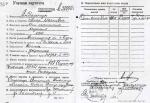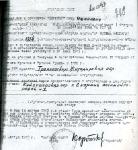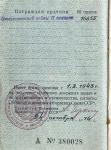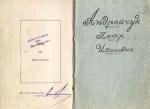-
Posts
619 -
Joined
-
Last visited
-
Days Won
2
Content Type
Profiles
Forums
Blogs
Gallery
Events
Store
Everything posted by Mondvor
-

Soviet Early Patriotic War for Artillery Officer
Mondvor replied to Mondvor's topic in USSR: Soviet Orders, Medals & Decorations
Apparently he was wounded... -

Soviet Early Patriotic War for Artillery Officer
Mondvor replied to Mondvor's topic in USSR: Soviet Orders, Medals & Decorations
From his Award Card we can see that after the end of the war he was transferred to reserve and worked as a Secretary of Zhitomir Regional Executive Committee. -

Soviet Early Patriotic War for Artillery Officer
Mondvor replied to Mondvor's topic in USSR: Soviet Orders, Medals & Decorations
Division. Born: 1914 Nationality: Ukrainian Party membership: member of Communist Party Participation in Great Patriotic War: since June 24, 1941 Wounds or contusions: wounded on August 13, 1941 In Red Army: since 1928 From what Military Registration Office was recruited: Troyanovskij District Office of Zhitomir Region Citation Previous awards: not awarded before Home address: Kuibishev oblast, city of Sizran, Military Settlement #1 Short description of merits: On January 16, 1943 at the region of Trud two enemy infantry companies started a counter attack against our front lines. At this time comrade Andreichuk was on the artillery firing positions. He quickly turned around our guns and opened fire. German attack was repelled and our infantry was able to accomplish its primary task. For his resoluteness and resourcefulness displayed in combat comprade Andreichuk deserves a state award ? Military Merit medal. Commander of 1032nd Artillery Regiment Major Korotkov January 22, 1943 Later commander of 107th Infantry Division Colonel Bezhko upgraded the citation to Patriotic War 2nd class. Andreichuk was awarded with Patriotic War 2nd class by a decree of 40th Army # 11/n from Febryary 10, 1943. -

Soviet Early Patriotic War for Artillery Officer
Mondvor replied to Mondvor's topic in USSR: Soviet Orders, Medals & Decorations
-

Soviet Early Patriotic War for Artillery Officer
Mondvor replied to Mondvor's topic in USSR: Soviet Orders, Medals & Decorations
-

Soviet Early Patriotic War for Artillery Officer
Mondvor replied to Mondvor's topic in USSR: Soviet Orders, Medals & Decorations
-

Soviet Order of Suvorov
Mondvor replied to Khyber's topic in USSR: Soviet Orders, Medals & Decorations
Andreas, Suvorov 10.439 is real. But if you compare serial numbers of this order and serial number of the fake order posted earlier by Khyber you'll see something interesting. -

Soviet Order of Suvorov
Mondvor replied to Khyber's topic in USSR: Soviet Orders, Medals & Decorations
-

Soviet Order of Suvorov
Mondvor replied to Khyber's topic in USSR: Soviet Orders, Medals & Decorations
This Suvorov was made from real order using high-pressure cast technology. First you have to take nice and precise impression from a real order. They use impression materials similar to those used in dentistry. The liquid metal forced to those impressions under very high pressure, so even small details reflected on the future surface of fake order. You can clearly see, that mint mark has original shape and even serial number has original handwriting pattern. About the obverse. Nose on Suvorov's face is OK. Late variation of Suvorov (appr. after 10.200) have this shape of nose. BTW, he looks like Putin little bit. -

Soviet Odd Award Card and Citation for Glory 3rd
Mondvor replied to NavyFCO's topic in USSR: Soviet Orders, Medals & Decorations
Thanks Dave, 39XXXXX really must be a mistake, because no numbers in 37XXXXX - 39XXXXX were observed during last several years. -

Soviet Odd Award Card and Citation for Glory 3rd
Mondvor replied to NavyFCO's topic in USSR: Soviet Orders, Medals & Decorations
Sorry, what is the number of second Bravery medal? In award card it looks like 3658186. If it is correct, then it is highest number for Bravery I've ever seen. Previous highest was 3658166. -

Soviet This is real?
Mondvor replied to usairforce's topic in USSR: Soviet Orders, Medals & Decorations
Paul, that is depends on what classification you want to apply -

Soviet This is real?
Mondvor replied to usairforce's topic in USSR: Soviet Orders, Medals & Decorations
This is 100% original Lenin. Does it have a document? -

Soviet Odd Award Card and Citation for Glory 3rd
Mondvor replied to NavyFCO's topic in USSR: Soviet Orders, Medals & Decorations
OK, back to Konyaev's awards. I think the situation with his Glory 3rd class is pretty clear. We have a citation and I have to say it's very cool! After his mortar was damaged with enemy artillery fire, Konyaev used his machine-gun and killed German sniper. After that he took his rifle and with this rifle he killed 8 German soldiers and an officer. Germans tried to surrender and capture Konyaev, but he threw 2 hand grenades and killed 5 more Germans. Now we have the most strange part - his 2 Bravery medals. According to the documents first medal was given to him in 1947 in the city of Polotsk. He was awarded by the Decree of his Regiment on April 29, 1945. Why it took two years to receive the award? Most likely he was wounded and transferred to the hospital or just transferred to the other unit. So regimental authorities were unable to find him in a war-time chaos. But after he was discharged from the army in 1946, he returned back home and registered in a local Military Office. Administrative officer from this department filled his papers and send them to the Central Office. And there they found that his Bravery medal is still waiting for him. But now his location was clear and they simply sent the medal to local Military Office and the Head of this Office called him and gave him his medal. The number of this medal matches with the data when it was given to recipient (1947). The first award card was filled at that time and shows two awards - Glory and first Bravery medal. What happened then? From the first award card we know that Konyaev moved away in 1948. Some time later he settled in the other place and again came to the local Military Office. Administrative officer sent the request again and received his initial award card from previous location. It was on May 22, 1956. He put the new seal that confirms that all entries are correct. And of course he informed Central Office that Konyaev changed his location and got registered in a different Military Office. And here is a moment of truth. When Central Office personnel reviewed Konyaev's papers they found this old citation for the Bravery medal. AND THEY THOUGHT HE DID NEVER RECEIVE IT!!! They sent another medal to new location. And he was awarded SECOND TIME. But now the number of the medal was higher and it perfectly matches with data of issue - 1956. Of course local Military Office clerk immediately filled the new award card to Konyaev and now two medals were listed. Of course it is only my hypothesis, I'm not absolutely sure how it was in reality. -

Soviet Odd Award Card and Citation for Glory 3rd
Mondvor replied to NavyFCO's topic in USSR: Soviet Orders, Medals & Decorations
Dave, this award group is really interesting. There are several strange moments with it and I think we should not combine them all together. Lets answer one question at a time. First of all, I do not believe he was some special guy who was sent to the battlefield on the last days of the war to get some medals... Last days of the war were sometimes more dangerous than in mid-war period. If you are familiar with Russian losses during the battle of Berlin, than you understand what I'm talking about. He joined the Army on March 1942. But started to participate in active combat only since March 1945. So what did he do for 3 years. There are manu possibilities. He could be on Far Eastern Front. During the whole war USSR kept huge number of troops near the border with China and Mongolia to prevent possible Japanese invasion. Also he could serve in one of Training Regiments. Soviet famous fighter and 3 times HSU Kozhedub spent the initial part part of the war as a pilot instructor in one of the Fighter Training Schools. But for the final battles Red Army required more people. So many units from Far Eastern Front and from Training Units were transferred to Western Europe for the "last fight". Dave, you posted only one side of each award card. If you post the other sides, I try to continue my explanation about other strange moments with his awards. The every small piece of information from those documents could be very valuable. -

Soviet Interesting Single Red Star
Mondvor replied to NavyFCO's topic in USSR: Soviet Orders, Medals & Decorations
Oh, sure! I've heard about "Star Trek" and saw couple of episodes on TV... -

Soviet Interesting Single Red Star
Mondvor replied to NavyFCO's topic in USSR: Soviet Orders, Medals & Decorations
Sorry Ed, who is Spock? -

Soviet Interesting Single Red Star
Mondvor replied to NavyFCO's topic in USSR: Soviet Orders, Medals & Decorations
Paul, I have full list of "Polevaya Pochta" ("Field Post-Office") military unit numbers, that were used in 1943-45. But for the post-war numbers there is no such information available. Probably this data is still classified, because many units still exist in moredn Russian Army. But some of them you can trace through the internet (like I did to find some information about 44708 unit). -

Soviet Interesting Single Red Star
Mondvor replied to NavyFCO's topic in USSR: Soviet Orders, Medals & Decorations
Military Unit 44708 in Russian would have that official name Представительство 10-го Главного Управления Министерстав Обороны - почтовый ящик 515-Б, аппарат Главного Военного Советника в Кабуле. In English it would be something like that Local Office of 10th Main Department of Ministry of Defence - mailbox 515-B, Headquarters of Chief Military Advisor in Kabul. I want to add that 10th Main Department of Ministry of Defence was a structure responsible for International Military Cooperation between the countries of Warsaw Block. It became extinct in 1992. So our guy most likely was one of the Military Advisors (probably in tank troops). -

Soviet Soviet Aviation Abbreviation
Mondvor replied to Paul R's topic in USSR: Soviet Orders, Medals & Decorations
Paul, you are welcome About abbreviations I must say that Soviet officials by some reason loved to create abbreviations. Some of them are so odd that even native Russian people unable to translate them -

Soviet Soviet Aviation Abbreviation
Mondvor replied to Paul R's topic in USSR: Soviet Orders, Medals & Decorations
Soviet Li-2 (exact copy of American DC-3) were assigned to the ADD as well. But they were less common than Il-4. They also carried out the functions of transport planes and paratrooper launchers. -

Soviet Order of the Red Star...
Mondvor replied to Paul R's topic in USSR: Soviet Orders, Medals & Decorations
Could be only one explanation. The guy has a nice group with missing Red Star. And this Red Star from Ebay is the one that he is looking for... Sounds very unreal, but what else could push the person to pay about 100 for a regular Red Star??? -

Unknown badges
Mondvor replied to Mondvor's topic in Great Britain: Militaria: Badges, Uniforms & Equipment
Thanks a lot, gentlemen! It's always good to learn more about the historical evnts behind those badges








